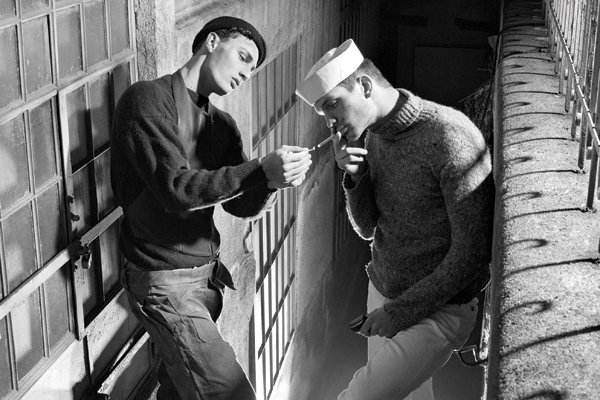John Malathronas is impressed with the exhibits of the first gay museum in the world, which recently celebrated its quarter century…
Berlin is one of the biggest gay destinations in Europe, up there with Amsterdam, Mykonos and Sitges; I should know, I’ve been in Germany’s capital more than a dozen times. But, although I knew of the existence of the Gay Museum – it was, after all, next to SchwuZ, one of the gay discos I frequented – I had never visited it. Who walks around Berlin during daytime, I ask you?
 My loss. Because when I did eventually venture inside a few weeks back, I was knocked for six. This was, this felt like… like a real museum! And an interesting one at that.
My loss. Because when I did eventually venture inside a few weeks back, I was knocked for six. This was, this felt like… like a real museum! And an interesting one at that.
“It was back in 2004 with the launch of our permanent exhibition, Self Confidence and Persistence, comprising 700 display items,” explained Karl-Heinz Steinle, the manager, “that the place started feeling like a proper museum. Until then it was just a series of temporary exhibitions.”
Drawing now 18,000 visitors a year, 60 percent of whom are tourists, the museum is celebrating its 25th year in 2011. It was founded on 6th December 1985 following the groundbreaking exhibition ‘Eldorado: History, everyday life and culture of homosexual women and men in Berlin 1850-1950’ in the then Berlin Museum and has been in its present site in Kreuzberg since 1988. The Gay Museum was the first of its kind in the world, and for years it was funded privately and manned by volunteers. It was only in 2010, long after its reputation had been established, that the state of Berlin granted it an annual endowment of €250,000.
“In fact we have been lending exhibits to other museums,” Karl-Heinz continued, “because no one had ever catalogued any items as ‘gay’. Even if collections had something relevant on gay history, they didn’t know. So museums such as the Holocaust Memorial Museum in Washington and the Imperial War Museum in London turned to us for assistance in order to document the homosexuals’ persecution by the Nazis.”
Indeed, the range of the collection is breathtaking. There is a book by Thomas Artus (alias Sieur d’Embry), Description of the Island of the Hermaphrodites written in 1605, which satirizes the effete nobility. There are languid oil paintings of male nudes such as the Blue Grotto at Capri by Ferdinand Flohr (1837) and a series of portraits of homosexual couples called simply, and demurely, ‘Friends’. There are photographs of female impersonators from the 1880s and some hardcore male pornography from that period depicting oral sex. There is a great collection of 1950s American ‘Beefcake’ physique photographs by artists such as Bruce of LA and Don Whitman.
Back to Karl-Heinz: “Our permanent exhibits present an overview of how the German Homosexual Movement, the first of its kind in the world, started in 1897 in Berlin, flourished in the early 20th century, broke down under the Nazis and started anew in the post-war era. We also show how it influenced the world and was influenced in return. Our photos, artwork and paintings show how the image of homosexuality changed through the centuries: from a Romantic view of Greek boy-love, to gay icons like Marlene Dietrich and David Bowie.”
 The museum’s special exhibitions – about ten a year – also help to highlight the work of contemporary gay photographers such as the Russian Slava Mogutin, the British Anthony Gayton and the German Fred H Berger. And its work continues behind the scenes: collecting items from simple kitsch to complete drag costumes, archiving (18,000 books will go online by the end of the year), researching – mostly oral history from older gay men and women – and, finally, simply storing material: it owns a mind-numbing library with 2,000 titles of newspapers and magazines from around the world.
The museum’s special exhibitions – about ten a year – also help to highlight the work of contemporary gay photographers such as the Russian Slava Mogutin, the British Anthony Gayton and the German Fred H Berger. And its work continues behind the scenes: collecting items from simple kitsch to complete drag costumes, archiving (18,000 books will go online by the end of the year), researching – mostly oral history from older gay men and women – and, finally, simply storing material: it owns a mind-numbing library with 2,000 titles of newspapers and magazines from around the world.
Karl-Heinz is very excited about the future. “2012 marks 90 years from the birth of Pier Paolo Pasolini, so we will devote a room about his work. But the next big project which will run for two years will be something never attempted before: a Cultural History of Female Homosexuality and a History of Transexuality, in documents and artwork.” I think this deserves a toast: to the Museum’s next 25 years.
• Schwules Museum Berlin, Mehringdamm 61, Kreuzberg. Entrance €5, €3 concessions. Open every day except Tuesday 2pm–6pm, Saturday 2pm–7pm.

















